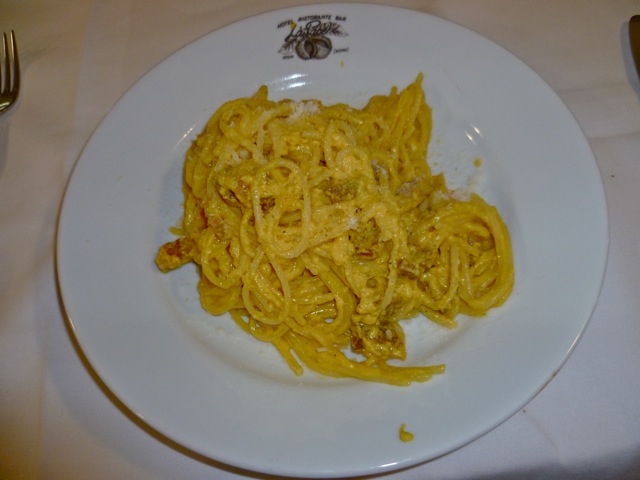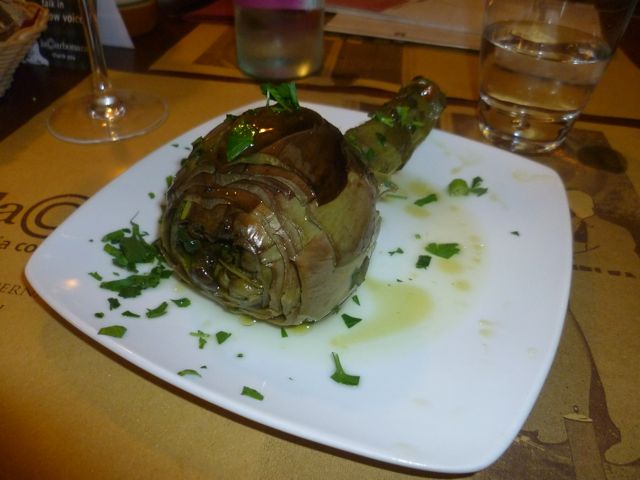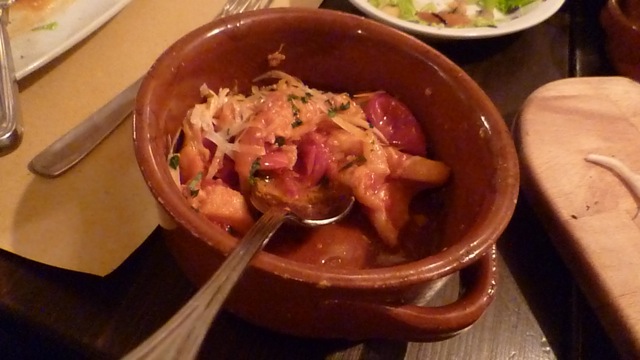
We know it's hard to believe, but all Italian dishes do not lead to Rome. Just as you wouldn't hit Los Angeles in search of great Manhattan Clam Chowder, you wouldn't head to Rome if you wanted a perfect plate of Neapolitan Spaghetti alla puttanesca. While it might be tempting to load up on "classic" Italian dishes from all regions during your Roman holiday, why not do as the Romans and enjoy the truly sensational, truly Roman specialties that typify Rome's delicious traditional cuisine?
Despite the city's imperial pedigree, Roman cuisine is the food of the people; flavored by lard and olive oil, perfumed by sage, rosemary, cinnamon, marjoram, and mint. Its flora are the artichoke, the pea, the puntarelle, the fava bean, and the chickpea. Its fauna are the pig, the lamb, and the cod. True to the cuisine's proletariat origins, no part of the animal goes to waste (don't believe us? Scroll down to Number 10 on this list). Roman food has also been influenced by the influxes of Jewish immigrants to the region. Rome's preferred cheese is the hard, salty Pecorino Romano. The slightly sweet Ricotta Romana comes in at a close second.
Ready? Set? Mangia - or as they say in Rome, magna! Below, a round-up of ten ultra Roman dishes not to be missed when you're in the Eternal City.
Bucatini all'amatriciana As in most of Italy, pasta is an important part of Roman cuisine. Bucatini - thick spaghetti with a hole running through the center - are arguably the most Roman of all Roman pasta shapes; the very devil to eat but oh-so-perfect for trapping a delicious sauce like the famous amatriciana. L'amatriciana - or matriciana, as it's often called locally - is made of tomatoes, peperoncino, guanciale (pig's cheek), and grated Pecorino Romano.
Get your fix at: Il Convivio Troiani, Vicolo dei Soldati, 31 (Roma). Tel: 06 6869432

Spaghetti alla carbonara Familiar to the English-speaking world as a cream, chicken, mushroom and pasta dish, the only thing authentic spaghetti alla carbonara has in common with its Anglicized derivative is the spaghetti. In Rome, spaghetti alla carbonara is dressed in raw egg yolk, black pepper, guanciale and grated Pecorino Romano. Sometimes pancetta is used instead of guanciale. Sometimes the dish is made with vermicello pasta or rigatoni. Any way you get it, it's divine.
Great plate at: La Carbonara, Via Panisperna, 214 (Roma). Tel: 06 4825176
Spaghetti cacio e pepe Spaghetti cacio e pepe is just about as simple as a dish can get, but about a hundred times more delicious than a dish should ever be. Three ingredients - Pecorino Romano cheese (cacio), black pepper (pepe), and leftover pasta water - make up the sauce, which is stirred into hot pasta to create a spicy, cheesy coating.
Try it at: Antica Pesa, Via Garibaldi, 18 (Roma). Tel: 06 5809236

Carciofi The artichoke (il carciofo) is the star of Roman produce, bursting into glory each summer. The two most Roman ways to prepare it are alla romana (Roman-style) or alla giudea (Jewish-style). The former method stuffs the artichokes with bread crumbs, garlic, mint, and parsley before braising them in a bath of olive oil and water. Carciofi alla giudea, in contrast, are beaten against a hard surface until the petals bloom open like a flower, and then deep-fried to golden perfection.
Enjoy carciofi alla romana at: Felice a Testaccio, Via Mastro Giorgio, 29 (Roma). Tel: 06 5746800
Or carciofi alla giudea at: Al Pompiere, Via di Santa Maria Dè Calderari, 38 (Roma). Tel: 06 6868377
Puntarelle Puntarelle are slightly bitter green leaves that are soaked in ice water until they curl up, then tossed with lemon juice, olive oil, and anchovies to make a crunchy, earthy salad.
Try them each late summer and fall at: Trattoria Perilli a Testaccio, Via Marmorata, 39 (Roma). Tel: 06 5755100
Abbacchio alla scottadito You can't visit Rome without eating lamb, whether you have it alla cacciatora, alla romana, or alla scottadito. Abbacchio alla scottadito - "lamb finger-burning style" - is lamb chops seasoned with salt, pepper, and herbs like thyme, tarragon and rosemary, before being rubbed with either lard or olive oil, grilled, and served with a lemon wedge. It is traditionally eaten with the fingers; hence the name.
Burn your fingertips at: Sora Margherita, Piazza delle Cinque Scole, 30 (Roma). Tel: 06 6874216
Filetti di baccalà fritti Roman fare tends to utilize the bounty of the pastures, but when it does call for seafood, its recipes include sardines, anchovies, or cod. Roman-style filetti di baccalà fritti (fried cod fillets) are crispy and savory. Wear the resulting streak of oil on your chest with pride.
Fresh catch at: Er Filettaro in Campo dei Fiori, Largo dei Librari, 88 (Roma). Tel: 06 6864018
Coda alla vaccinara Rome's protein-rich recipes are routinely spiced up by ingredients from the quinto quarto - the "fifth quarter" of the animal. That is, offal. Common in quinto quarto dishes are tripe, pigs' feet, brain, heart, liver, kidneys, tongue, pancreas, and salivary glands.... just to name a delicious few. Coda alla vaccinara (butcher-style oxtail) is one of the most famous of these Roman variety meat-based recipes. It is made by stewing oxtail, celery, onions, guanciale or lard, garlic, cinnamon, and other aromatic herbs.
Grab the ox by the tail at: Checchino dal 1817, Via di Monte Testaccio, 30 (Roma). Tel: 06 5746318

Trippa alla romana You might balk at the very idea of tripe - the texture, the pungent smell, the sheer offal-ness of it - but then, you've probably never had it Roman-style. Simmered in a spicy tomato sauce to a velvety, buttery softness; you'll swear you were eating heaven.
Blow your tripe-fearing mind at, again, Checchino dal 1817. Locals swear it's the best for quinto quarto recipes.
Rigatoni con la pajata And just how far do the Romans go with their use of the quinto quarto? Pretty far; rigatoni con la pajata is pasta prepared with a sauce made from the "creamy" contents of a milk-fed calf's small intestine. In recent years, the dish has been deemed unlawful and thus stricken from many Roman menus, but devoted insiders still know where to get their pajata fix.
Get milk-fed at: Bucatino a Testaccio, Via della Robbia, 84/86 (Roma). Tel: 06 5746886